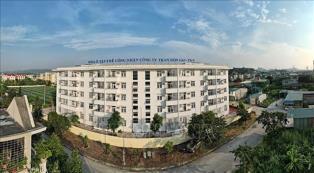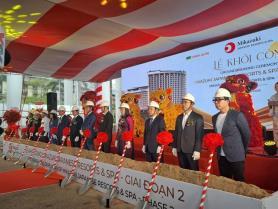In Q2 2025, Hà Nội continued to lead the nation in apartment price growth, with the average selling price reaching VNĐ75.5 million per square metre, up 7.7 per cent quarter-on-quarter.

HÀ NỘI — Despite a strong recovery in Hà Nội’s apartment market over the past year, a growing imbalance between supply and demand is becoming increasingly apparent, as affordable housing has almost vanished and prices continue to climb beyond the reach of most urban residents, especially the younger population.
According to figures from the Vietnam Association of Realtors (VARS), the supply of apartments in Hà Nội saw a steep decline between 2018 and 2023, dropping from over 20,000 units in 2018 to just around 10,000 units in 2023.
This reduction was accompanied by the near-complete disappearance of the affordable housing segment, priced below VNĐ25 million (US$960) per square metre, which made up 35 per cent of total supply in 2019 but saw no new developments launched in 2023.
In 2024, supply showed signs of recovery, with approximately 30,000 new apartments brought to market, the highest figure in five years. During the first half of 2025, over 10,000 additional units were introduced.
Nonetheless, there remains a significant mismatch between pricing and actual demand. VARS noted that 60 per cent of apartments launched in the first half of 2025 were priced above VNĐ80 million per square metre. Since the third quarter of 2024, no new developments have been recorded with prices below VNĐ60 million per square metre.
Even in Hà Nội’s suburban districts, starting prices now begin at VNĐ55 million per square metre.
“Overall, the supply of affordable commercial apartments is becoming increasingly scarce in Hà Nội, and even the mid-range segment is shrinking and could vanish in the near future,” warned Nguyễn Văn Đính, chairman of VARS.
He stressed that even high-end apartments priced below VNĐ60 million per square metre are becoming rare, pushing homeownership further out of reach for middle-income earners.
In Q2 2025, Hà Nội continued to lead the nation in apartment price growth, with the average selling price reaching VNĐ75.5 million per square metre, up 7.7 per cent quarter-on-quarter and nearly 90 per cent higher than in 2019 (the sharpest rise came in the last 1–2 years).
Developers have persistently introduced new projects at higher price levels and adjusted up prices of unsold inventory, further driving up prices on the secondary market.
However, secondary market liquidity remains low. Transactions are mostly concentrated in completed mega-urban projects or luxury apartments in central areas priced around VNĐ50 million per square metre. At current price levels, not only low-income but also upper-middle-income buyers are struggling to access housing.
Trần Văn Bình, general secretary of VARS, said: “Many young people, even those earning VNĐ40–50 million per month, are hesitant to purchase property without financial support from their families. The pressure of large mortgage repayments, especially when floating interest rates surge after initial incentives, deters many.”
Bình added that today’s youth increasingly prioritise experiences and flexible spending over committing to long-term debt simply to own a small apartment. This mindset could lead some to financial disorientation and a 'live for the moment' lifestyle, spending on luxury goods or short-term pleasures rather than saving for a home, a trend already seen in South Korea.
"Others may choose to 'lie flat', giving up on homeownership altogether and losing motivation to strive, similar to what is unfolding in China.
In the short term, VARS forecasts that apartment prices in Hà Nội will continue to rise due to high input costs and investors’ strong profit expectations. Many investors are under little financial pressure and have no incentive to lower prices. On the contrary, profit expectations are rising amid low interest rates, abundant cheap capital, and accelerated public investment policies. — VNS




